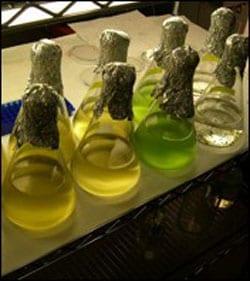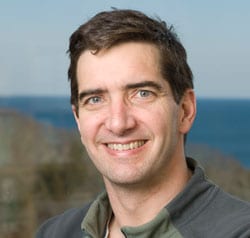Airborne pollutants can be toxic to marine algae
March 10, 2009
A newly published paper by ocean scientists shows that airborne particles off the continents can have deadly effect on some marine phytoplankton. The findings, published in the online early edition of the Proceedings of the National Academy of Sciences (PNAS) the week of March 9, 2009, have implications for atmospheric carbon dioxide levels and climate.
Many experiments have been conducted, particularly with iron, to show how aerosol deposits in the ocean are an important source of nutrients and trace metals that can enhance phytoplankton growth. But, says lead author Adina Paytan from the University of California, Santa Cruz, “this is the first time that toxicity from atmospheric aerosols has been reported for the ocean system.”
Plankton are a critical component of Earth’s climate system: as part of their life cycle, they draw carbon dioxide out of the air and transfer it into the deep sea.
Working with researchers from Woods Hole Oceanographic Institution (WHOI), Cornell University, the US Geological Survey and Interuniversity Institute of Marine Sciences in Israel, Paytan suggests that high concentrations of copper could be responsible for the toxic effects the team noted during a study of how phytoplankton respond to atmospheric aerosols deposited in the northern Red Sea.
Most of the copper deposits in the ocean come from natural sources of dust, manmade sources accounted for roughly 40 percent. Using data from various sources on copper concentrations in aerosols, global distributions of aerosols, and aerosol deposition rates, the researchers developed models that suggest certain areas–such as the Bay of Bengal and downwind of South and East Asia–are particularly at risk for the effects of copper deposition on ocean ecosystems.
The researchers say there may be other pollutants in atmospheric aerosols that could also have toxic effects on marine phytoplankton. “We need to do more extensive sampling of aerosols over larger areas and over greater lengths of time,” said Scott Doney, a geochemist and ocean modeler at WHOI who assisted Paytan with the numerical analysis of the satellite and field data. “We also need to start thinking about varying responses from different biological species in the planktonic community.”
This research was supported in part by grants from NASA, NATO, and the National Science Foundation.
The Woods Hole Oceanographic Institution is a private, independent organization in Falmouth, Mass., dedicated to marine research, engineering, and higher education. Established in 1930 on a recommendation from the National Academy of Sciences, its primary mission is to understand the oceans and their interaction with the Earth as a whole, and to communicate a basic understanding of the oceans’ role in the changing global environment.
To see the UCSC press release, please see http://www.ucsc.edu/news_events/press_releases/text.asp?pid=2777.


